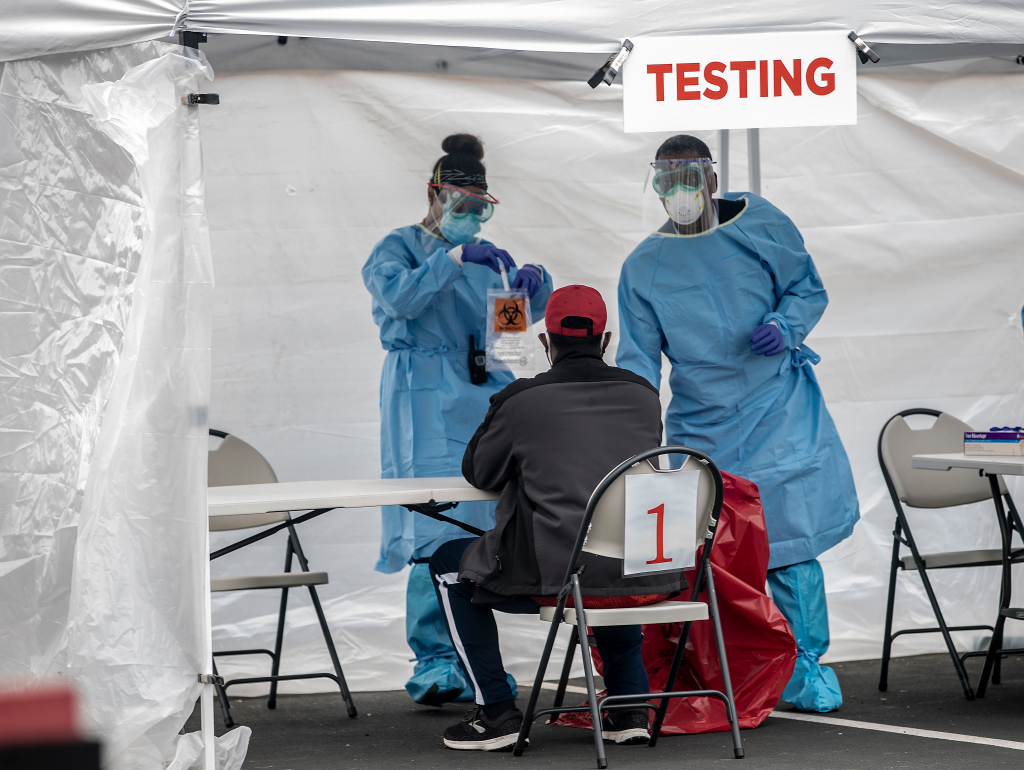As part of a bid to get the coronavirus pandemic under control, California’s top health care officials said Tuesday the state would roll out new guidelines focused on expanding testing among communities and populations who are particularly vulnerable to the disease, and prioritizing which samples are analyzed first.
The news comes as case counts in the Golden State continue to rise and as some testing sites and labs say they have been overwhelmed by demand, even as it has become more difficult to get all the necessary supplies. The situation mirrors the early days of the pandemic, when there were severe shortages of test kits and some critical components.
But back then, in early April, the state was conducting around 2,000 tests a day. Now, that figure is north of 100,000. Still, California Health and Human Services Secretary Mark Ghaly said during a press conference that there is more to be done as communities contemplate reopening schools, offices and more.
“We all know that testing in California is a vital piece of our response,” Ghaly said.
And while the state wants to “maintain access” to testing for the general population, Ghaly said, it will focus first on those with symptoms in an effort to curb transmission of the deadly virus.
As the state develops a targeted testing plan, it is calling on private hospitals, clinics, labs and other health care providers to offer COVID-19 tests in a bid to expand access to testing. Many are already offering at least some testing, but the state hopes to increase the number of places where residents can get tested and encourage those already running tests to do more. In a similar move at the local level, Santa Clara County recently called on health care giants like Kaiser and Sutter to boost testing.
“Over time, the county cannot maintain the ability to provide this type of service for the entire community and entire population,” Marty Fenstersheib, head of the county’s testing task force, told this news organization last week. “So, realizing that, as we open up, we need to be able to contain this disease.”
But some health care providers have warned that national limitations on testing reagents used in labs could make it challenging to expand testing.
UCSF on Monday said it had 56 days worth of testing kit supplies on hand, but warned that the surge in cases will impact testing capacity everywhere.
“With the current surge, we are already seeing much longer turnaround times in outside labs (from about 24 hours before to 6-7 days now), so we have been getting increasing requests for testing in ours,” UCSF said.
“Health care professionals have truly done heroic work meeting this moment,” Lourdes Castro Ramirez, the secretary of the Business, Consumer Services and Housing Agency, said during Tuesday’s press conference. “I know they will continue to play a key role.”
Ghaly on Tuesday announced two new leaders of the state testing task force: Gilbert Chavez, from the California Department of Public Health’s Center for Infectious Diseases, and Bechara Choucair, senior vice president and chief health officer for the Kaiser Foundation Health Plan.
“While we have learned a ton about COVID-19 and we’ve made a lot of progress, our recent surge in cases makes it clear a lot more must be done to protect our communities from this unprecedented pandemic,” Choucair said.
The task force will look for ways to reduce the cost of testing, in part by exploring possible innovations in testing. Right now, Ghaly said, providers pay about $100 per test, but the state would like to see that figure decline.
“We must be deliberative and also creative,” Castro Ramirez said, “about how we are continuing to meet this moment.”
Staff reporter Fiona Kelliher contributed reporting.



















